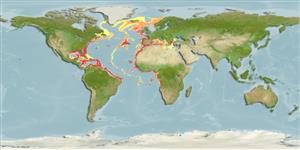Common names from other countries
>
Gadiformes (Cods) >
Macrouridae (Grenadiers or rattails)
Etymology: Nezumia: A Japanese word that means "mouse" .
More on author: Günther.
Issue
This species is often confused with Nezumia sclerorhynchus (Valenciennes, 1838).
Environment: milieu / climate zone / depth range / distribution range
Ecologia
marinhas bentopelágico; não migratória; intervalo de profundidade 200 - 2320 m (Ref. 3587), usually 200 - 1000 m (Ref. 2683). Deep-water; 70°N - 12°S, 98°W - 30°E (Ref. 1371)
Atlantic Ocean: Eastern Atlantic: Faroe Bank to northern Angola and the Mediterranean Sea. Western Atlantic: Davis Straits to northern Brazil.
Comprimento de primeira maturação / Tamanho / Peso / Idade
Maturity: Lm 4.5, range 4 - ? cm
Max length : 36.0 cm TL macho/indeterminado; (Ref. 3587); common length : 25.0 cm TL macho/indeterminado; (Ref. 2683); idade máx. registrada: 9 anos (Ref. 58045)
Espinhos dorsais (total) : 2; Espinhos anais: 0. Head short, completely scaled except for naked strip on the ventral surface of the snout; Eyes relatively large, 29 to 42% of head length; snout short, pointed; chin barbel very short. Body scales with lanceolate to shield-shaped spinules. Overall color is bluish to violet, head somewhat tawny to swarthy; ventral portions silvery when fresh; pelvic fins black except outermost ray which is pale to white; oral cavity grayish; branchial cavity mostly black.
Feeds on benthic as well as pelagic animals like mysids, amphipods, small shrimps, copepods, isopods, ostracods and polychaete worms (Ref. 6187).
Ciclo de vida ou comportamento de acasalamento
Maturities | Reprodução | Spawnings | Egg(s) | Fecundities | Larvas
Cohen, D.M., T. Inada, T. Iwamoto and N. Scialabba, 1990. FAO species catalogue. Vol. 10. Gadiform fishes of the world (Order Gadiformes). An annotated and illustrated catalogue of cods, hakes, grenadiers and other gadiform fishes known to date. FAO Fish. Synop. 125(10). Rome: FAO. 442 p. (Ref. 1371)
Status na Lista Vermelha da UICN (Ref. 130435)
CITES (Ref. 128078)
Not Evaluated
Ameaça para os humanos
Harmless
Uso pelos humanos
Pescarias: pouco comercial
Ferramentas
Relatórios especiais
Baixar XML
Fontes da internet
Estimates based on models
Preferred temperature (Ref.
115969): 4.7 - 15.7, mean 9.3 (based on 786 cells).
Índice de diversidade filogenética (Ref.
82804): PD
50 = 0.5000 [Uniqueness, from 0.5 = low to 2.0 = high].
Bayesian length-weight: a=0.00182 (0.00111 - 0.00298), b=3.12 (2.97 - 3.27), in cm Total Length, based on LWR estimates for this species & (Sub)family-body (Ref.
93245).
Nível Trófico (Ref.
69278): 3.3 ±0.1 se; based on diet studies.
Resiliência (Ref.
120179): Baixo, tempo mínimo de duplicação da população 4,5 - 14 anos (Preliminary K or Fecundity.).
Fishing Vulnerability (Ref.
59153): Low to moderate vulnerability (26 of 100).
